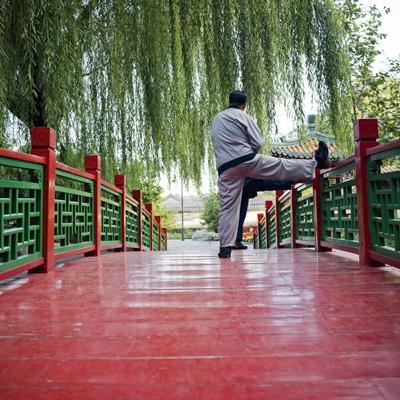Tai chi

Modern tai chi is a meditative martial art form practised by millions of people all around the world. In China, it’s common to see people doing a routine in the park in the early mornings before work.
This type of complementary therapy has recently gained much respect from researchers for its health benefits – particularly for improving strength and balance. Best of all, anyone can get involved with tai chi as it’s a very low-impact, feel-good form of exercise.
Tai chi – the mystery
Tai chi para personas ocupadas
Tai chi, healthy and glee
Tai chi for everybody
Tai chi, is it for me?
Action points
Tai chi – the mystery
Little is known about the origins of tai chi. According to a popular Chinese legend, it was first devised by a Taoist monk called Chang San-Feng – hence its alternative name ‘tai chi chang’. It’s thought the movements are based on those of animals, in which you move your body slowly, gently and gracefully through a series of postures. The emphasis is on meditation. This means you try to put aside distracting thoughts, concentrate and breathe in a deep and relaxed way. Once you have learnt a routine, you should be able to move seamlessly from one posture to another.
Tai chi for busy bees
The most popular form of tai chi is the Yang style, which has 108 postures. There are four other forms known as Chen, Hao, Wu and Sun. As the postures have no set routine or time limit, you can practise tai chi at your leisure, for as long or as little as you like, and in a place that suits you.
Tai chi, healthy and glee
According to traditional Chinese medicine, an energy known as ‘qi’ (pronounced chi) runs through our bodies. If you’re stressed or unwell, it’s thought the flow of qi will be disturbed. In tai chi, the concepts of yin and yang (opposing forces) are used to help restore the flow of qi and maintain a healthy balance in your body. Although these concepts aren’t recognised in modern medicine, researchers have acknowledged the physical and psychological benefits of tai chi. For example, regular sessions may be able to improve your overall health and mental wellbeing, and help relieve the symptoms of some long-term conditions.
- Osteoarthritis. If you have osteoarthritis, tai chi may be able to help reduce pain or joint stiffness, particularly in your knees.
- Rheumatoid arthritis. Although tai chi may not be able to significantly reduce tenderness or swelling in your joints, it can improve your flexibility, especially in your ankles.
- High blood pressure. Regular tai chi training sessions may help reduce your blood pressure over a number of weeks. Recent studies have also shown it may be able to reduce high blood pressure in people who have had a heart attack or heart failure.
The long-term benefits of tai chi are still unknown and more research is needed to fully understand exactly how it affects the way your body works. However, it’s a safe, feel-good form of exercise that has been shown over the centries to boost mental wellbeing, keeping you healthy and happy.
Tai chi for everybody
Because tai chi is low impact (which means it won’t put much pressure on your bones and joints) most people should be able to do it. This is good news, especially if you’re not as young as you used to be and would like to become more active. For example, a tai chi training programme may help you develop your muscle strength, flexibility, balance and reaction time. This will keep you steadier on your feet and therefore decrease your risk of falling. If you’re less likely to fall, then there is a lower chance of you breaking a bone and having to cope with all the problems this brings.
Tai chi, is it for me?
As with any form of exercise, it’s important to speak to your GP before you start training in tai chi, especially if you have an existing health condition. If you’re pregnant, have a hernia, back pain or severe osteoporosis, your specialist or tai chi instructor may advise you to modify or avoid certain postures. Don’t let this put you off though; you can still participate, just be cautious of trying out some of the more advanced postures. If you build up your strength and balance gradually, you will become more confident and skilled over time.
So, if you want to do a low-impact, meditative form of exercise, why don’t you tai something new today?
Action points
- Consider your health. If you have a medical condition, or haven’t exercised for a long time, speak to your GP before you start doing tai chi.
- Do some research. Make sure you find out about your tai chi instructor’s qualifications and experience before you begin a training programme.
- Get stuck in. It’s a good idea to join a group or class at first, especially if you’ve never done tai chi before.
- Have fun. Tai chi is practised all around the world by millions of people every day and for good reason – it’s relaxing, invigorating and enjoyable.
Further information
- Tai Chi Union for Great Britain
01403 257918
www.taichiunion.com
Sources
- Tai chi. National Centre for Complementary and Alternative Medicine. http://nccam.nih.gov, published April 2009
- Wang C, Collet JP, Lau J. The effect of tai chi on health outcomes in patients with chronic conditions. Arch Intern Med, 2004; 154(5):493–501
- Gillespie LD, Robertson MC, Gillespie WJ, et al. Interventions for preventing falls in older people living in the community. Cochrane Database of Systematic Reviews 2009,Issue 2. doi:10.1002/14651858.CD007146.pub2
- Thornton EW, Sykes KS, Tang W. Health benefits of tai chi exercise: improved balance and blood pressure in middle-aged women. Health Promot Int, 2004; 19(1):33–38.
- 2004; 19(1):33–38. doi:10.1093/heapro/dah105
- Osteoarthritis: treatment and medication. e-medicine. http://emedicine.medscape.com, published 14 January 2010
- Han A, Judd M, Welch V, et al. Tai chi for treating rheumatoid arthritis. Cochrane Database of Systematic Reviews 2009, Issue 1. doi:10.1002/14651858.CD004849
- Kannus P, Sievanen H, Palvanen M, et al. Prevention of falls and consequent injuries in elderly people. The Lancet, 2005; 366(9500):1885–93. doi:10.1016/S0140-6736(05)67604-0















